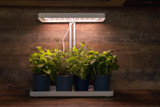Diagnosing Issues with High Intensity Discharge Lights in Your Grow Room
High Intensity Discharge (HID) lights have become a popular choice for those cultivating cannabis. They generate a robust light output, promoting healthy growth and substantial yields. Someone growing cannabis needs reliable light, and HID lights are like the sun in your grow room, providing the much-needed energy for plants to thrive.
However, like any equipment, HID lights can sometimes be finicky. Some common issues include flickering, inconsistent brightness, or trouble getting started. These problems can leave growers rather puzzled, as they scratch their heads and wonder what's happening with their trusty light sources.
Identifying Common HID Light Problems
Understanding the challenges that frequently pop up with HID lights is the first step toward finding solutions. Here are some typical issues you might encounter:
- Flickering or Inconsistent Light Output: Plants need consistent light to grow well. Flickering light might disturb the regular growth cycle and can be pretty frustrating for growers.
- Issues with Starting or Frequent Burnouts: Finding that your lights won't start or burnout quickly can be annoying. It’s like having one of your car's spark plugs not firing up.
- Changes in Light Color or Intensity: Sometimes, you might notice that the light color shifts or doesn't seem as bright as it should be. This could mean the light isn't providing the full spectrum needed for optimal plant growth.
Observing these problems early on can prevent larger issues down the line. HID lights are important for growth, but they require attention and care to keep them functioning correctly. By noticing these signs, you can ensure your grow room is an environment where your plants can flourish. Keeping an eye out for these issues and addressing them promptly can make a difference in sustaining a productive growing space.
Diagnosing Electrical Issues
When HID lights begin acting up, the cause often traces back to electrical problems. Start by examining the wiring and connections. Faulty wiring can disrupt the flow of electricity, leading to flickering or non-functioning lights. Just like a loose plug can affect how your TV shows an image, poor connections can prevent your lights from working right. Secure connections ensure a steady flow of power.
Voltage levels play a critical role too. If the voltage fluctuates or doesn't match the bulbs’ requirements, lights might flicker or fail to start. Use a voltage meter to check your electrical supply. Consistent voltage is key to maintaining a reliable light source for your plants. If you're not familiar with how to check these things, it might be a good idea to reach out to someone who does this regularly.
Another important aspect is using quality ballasts. Ballasts regulate the flow of electricity to the HID bulbs. If a ballast is subpar, it can cause issues like irregular light output or even short circuiting. Investing in reliable ballasts means fewer headaches and better performance from your lights.
Maintaining Optimal Light Conditions
Keeping HID lights in top shape requires some regular TLC. A good cleaning schedule can prevent buildup of dust and debris on bulbs and reflectors. Clean equipment not only lasts longer but also works better. Wipe down lights and reflectors with a soft cloth to remove any dirt that might block light. Also, ensure you're replacing bulbs according to the manufacturer's advice. Over time, even if they haven’t burnt out, bulbs lose efficiency and might not emit the right spectrum of light needed for growth.
Keeping an eye on the position of your lights impacts how effectively they work. Adjusting the height and angle can make sure the plants receive even light distribution without unnecessary heat build-up. Avoid placing them too close, which might cause overheating, or too far, reducing their effectiveness.
Troubleshooting Bulb and Reflector Problems
Sometimes everything’s fine with the wiring and position, but the light still doesn’t seem right. This could be because of issues with the bulbs or reflectors. Start by checking bulbs for any visible damage. If a bulb appears discolored or is flickering, it might be time for a replacement. Bad bulbs often show signs before they stop working.
Reflectors are another area to examine. They control the distribution of light, ensuring it reaches all plants evenly. Over time, reflectors can gather dirt or become misaligned. Clean them regularly and check their angles to ensure they are directing light in the best way possible.
Bright Future for Your Grow Room
Keeping your HID lights in good condition is all about regular care and understanding the potential problems. By maintaining wiring, monitoring voltage, and cleaning your equipment regularly, you ensure a stable and productive light environment for your plants. Remember that investing time and a little effort in your lighting system can make a big difference in the health and yield of your cannabis crop.
Knowledge is power, and being able to diagnose and address HID light issues directly not only improves your grow room but also boosts your confidence as a grower. Your plants depend on good light to thrive, and with these tips, you’re well on your way to a vibrant and flourishing grow room.
For those looking to dive deeper into optimizing and troubleshooting their grow room lighting, Shore Grow offers extensive resources. Learn how a well-maintained high intensity discharge system can support healthier plant development and improve your overall cultivation setup. With Shore Grow's expert advice and top-quality products, you're never alone on your path to a thriving harvest.
Recent Posts
-
How to Adjust LED Grow Light Settings for Optimal Growth
LED grow lights have become a favorite tool for many cannabis growers, thanks to their efficiency an …Oct 29th 2025 -
Must-Have Lighting Accessories for Any Grow Room
Starting a cannabis grow room can be quite an adventure, especially when it comes to picking the rig …Oct 29th 2025 -
Tips for Resolving Inefficiencies in High Intensity Discharge Lamps
High Intensity Discharge (HID) lamps play a crucial role in hydroponic cannabis cultivation, offerin …Oct 22nd 2025




